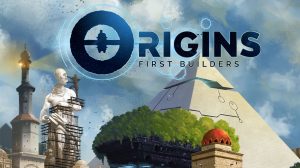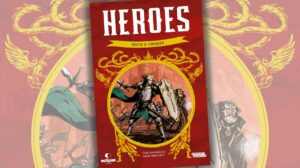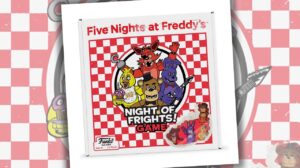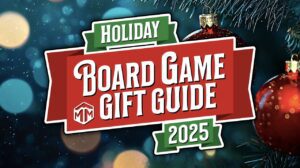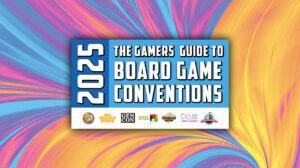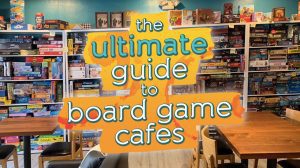Disclosure: Meeple Mountain received a free copy of this product in exchange for an honest, unbiased review. This review is not intended to be an endorsement.
At the Bell compound, it’s really no contest: the most played family game we have received from a publisher since I started writing for Meeple Mountain in 2021 is The Quest Kids, a dungeon quest game with handsome standees, cute monsters, loads of treasure, and the best score-tracking sheet the world has ever known. (It’s also the only game we own where we have used all the score pad sheets!!)
The Quest Kids, in the eyes of the children, is solid gold. However, one surprise has surfaced since the game arrived in 2021: apparently, children do, in fact, age. The lovely kids who were once ages seven and four are now four years older, and they apparently don’t always want to track their scores then color in the entire sheet before running out to play with their friends.
With that as our frame, I picked up a review copy of Super Trains, the spiritual successor to The Quest Kids. Both games are published by Treasure Falls Games. Both games are semi-cooperative experiences framed in a hunt for treasure and an opportunity to score points by helping other players defeat monsters or, in the case of Super Trains, deal with “emergencies.” (Some of the emergencies definitely look monstrous.) Both games come in deluxe editions with cool-looking sculpts and definitely have gamer parents in mind, right down to player boards that are used to track resources and upgrades.
While my kids have outgrown much of what made The Quest Kids shine, Super Trains does a nice job of iterating on the initial game to “age up” a similar experience. I just wish Super Trains didn’t take so long!

Cue the Theme Music
Super Trains is a dice-chucking resource gathering game for 2-5 players. Taking on the evil monster truck Rollar, players work together to address a slow-building series of issues known as Emergencies around the board to score points and hopefully defeat Rollar before the end of the game. (Strangely, beating Rollar directly is not a solvable game condition; if the players knock out all the Emergency cards, they will win, but even if they don’t, the game still ends two rounds after the final Emergency is revealed.)
In a nod to “everyone gets stuff” games like Machi Koro, Space Base, or Valeria: Card Kingdoms, each turn plays out the same way. One player rolls three dice, two of which dictate Rollar’s movements and the potential for more emergencies to be added to the board. The third die produces gears in a certain color (red, blue, yellow, green) that are spit out onto gear generators on each player’s personal boards. Thanks to a Puerto Rico-style active player bonus, the person who rolled the dice might get as many as three gears, with each other player getting one gear if they have the space and the matching gear generator color on their mat.
Then, play moves into the Super Trains phase. The active player has a lot of flexibility to move their train piece around the board to drop off passengers (think the Mission cards from The Quest Kids version of the system), complete Cargo quest cards by spending gears, or addressing Emergencies by spending 2-6 gears to score end-game points or pick up additional gear generators that can be placed on player mats. Players can also spend gears to upgrade their trains, which grants superpowers to that train for the rest of the game.
Sometimes, Rollar damages the good guys by moving into the same space as a player…and like The Quest Kids, players can take damage if they reveal a face-down Emergency card and they don’t get enough help from other players. Still, there are no life bars or hit points in Super Trains, because none of the players can be eliminated by poor play and bad luck.
Otherwise, this is a breezy time at the table…until roughly the middle of each play. That’s when the repetitive nature of the gameplay really sets in.

Kids Games Have to Move!
Our first play of Super Trains—three players, all of whom needed just a brief list of the differences to understand how Super Trains evolved from the system created by The Quest Kids—took 80 minutes. I am still somewhat shocked that it took so long. The kids liked what they saw at first, but as play dragged on, I got the sense that other activities were calling them to leave the table, like eating dinner or playing outside.
One thing that really hurts Super Trains is the way Emergencies enter play. Emergencies have to be rolled in order to be added to one of the game’s six locations. The six-sided die that dictates this rollout has two sides that move the Rollar figure, and four sides that reveal missions. In our first game, we rolled a LOT of Rollar movement icons, meaning we didn’t get a lot of fresh meat on the board. (This did give us ample opportunity to drop off passengers and complete Cargo cards, though…so, our production engines were roaring by the time Emergencies did show up.)
There’s really no way around this given the rule set, although one could just house rule that and have Emergencies show up on every turn. But for kids of a certain age—Super Trains recommends ages seven and up—some of the turns are a little too long, and the overall game length can really drag down the experience.

My other issue with Super Trains is the same issue I had with The Quest Kids: both games are really, really easy. For the most part, we found that solving Emergencies (either directly, or with the help of other players through the “Kind Train” mechanic) was usually very doable until the end of the game, when players typically needed all three gear types used to beat an Emergency. Planning ahead for these items was relatively straightforward. Filling out the entire player board with tiles was also, usually, pretty easy.
I’m all for games that take it easy on a child, since at least one of my kids hates losing. Still, I wish this was a little more challenging for my family to work through.
One last point of critique, given that The Quest Kids had the best score pad in family game history: Super Trains doesn’t feature a score pad at all. While my kids were the ones most interested in a fun way to keep score at the end, even I admit that having anything to help track scores (a score track on the main board, a score pad, victory point tokens, etc.) would have been appreciated. But there’s nothing like that here.
Super Trains was a fun ride. It tickled the itch offered by past plays of The Quest Kids, with a great table presence and a simple play system. Successive plays have brought the playtime down to about an hour. That’s still a little long so we are hoping to continue pushing the playtime down a bit. For families with young children, particularly 4-6 years old, I can’t recommend The Quest Kids enough, and playing Super Trains actually reminded me a lot of why I loved the simple nature of The Quest Kids system.
Give either game a look if you are in the market for more ways to entertain the young children of your family!



